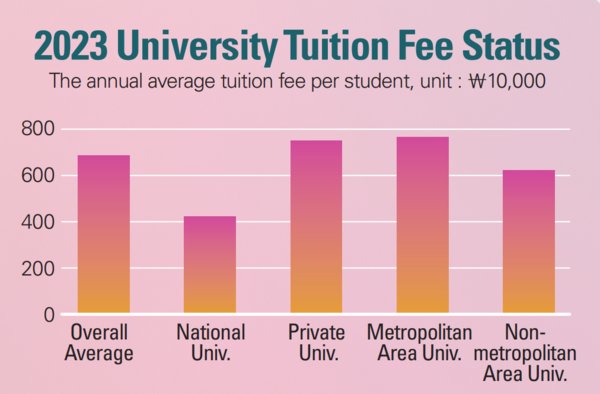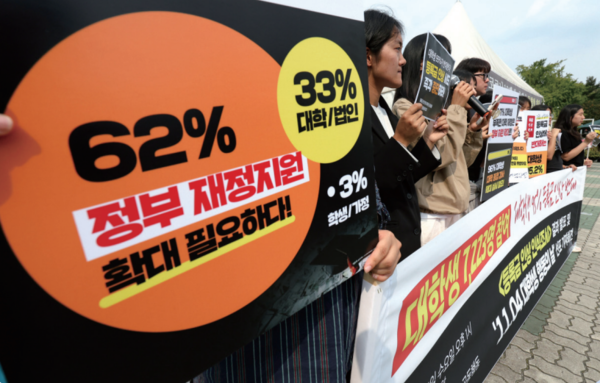The 15-year freeze on university tuition fees seems to have hit a snag. According to a survey conducted during the regular meeting of the Korean Council for University Education (KCUE) on July 9th, 53.5% of four-year nationwide universities’ presidents are considering tuition fee increases. This has led to the rallying of student bodies in opposition to the tuition fee increase. Hence, the Sungkyun Times (SKT) aims to explore the background of the tuition fee increase, arguments between universities and students, and potential solutions for the tuition fee hike.
Tuition Freeze Is Melting
-Freeze, Tag!
The tuition fee freeze policy was introduced in 2012 to reduce the actual financial burden on students by differencing scholarship support based on income levels. According to the University Education Research Institute (UERI), the tuition fee increase rate soared to 6.7% in 2008. This led university students to suffer financial burden, resulting in the continuation of the tuition fee freeze until now. In response, a tuition fee increase cap was introduced in 2011, to prohibit tuition fees from increasing more than 1.5 times the average consumer price index (CPI) over the previous three years. In 2012, the government accelerated imposing the tuition fee freeze by regulating the support of the Government Grant Type II fund given to the universities in the national scholarship system. Consequently, most universities’ undergraduate tuition fees have remained frozen for more than 10 years, including those of Sungkyunkwan University (SKKU). However, there are signals that the era of a tuition fee freeze may end. According to the research of the Tuition Fee Review Committee of UERI in April, 44.6% of universities increased tuition fees for at least one category among undergraduate, graduate, and international students, with an 8.8% increase in undergraduate tuition fees.

-What Causes the Melting?
Universities state that the government has forced them to freeze tuition fees. They argue that the government has prohibited the participation of universities that increase tuition fees in various financial support programs and has included a “tuition fee increase rate” as an evaluation criterion in the university’s work-study scholarship program. Until now, receiving compulsory support from the government was urgent, but now universities argue that they cannot cover their finances only with government support. One of the main factors driving the recent move is inflation. According to the KCUE, CPI increased from 83.9 to 107.7 from 2009 to 2022, while tuition fees have frozen since 2009. At the same time, universities are experiencing another financial crisis. The decreasing number of freshmen and the increase in public utility costs and labor expenses serve as the basis for the tuition fee increase. Furthermore, the university’s reserve funds have been depleted. The reserve funds refer to funds set aside for a specific management purpose, mainly sourced from tuition fees and donations. According to President Lee Hae-woo of Dong-A University, due to the complete depletion of reserve funds, Dong-A University will suffer a deficit of \2 billion this year if the tuition fee remains frozen.
System Error, Tuition Fee Increase
-Conflicts between Students and Universities

Differences in the perspectives of students and universities on the financial crisis, particularly regarding reserve funds, heighten the dispute over tuition fee increases. Despite reserve funds, the structural constraints of the utilization system imprison universities into a “financial crisis.” According to an interview with the Office of Budget Planning in SKKU, reserve funds are broadly divided into principal preservation funds, which require permission from donors for usage, and discretionary funds. The discretionary funds are further divided into several categories, such as general, research, and scholarship funds. Among these categories, the remaining funds available for autonomous usage are limited and even require approval from the Fund Committee. Additionally, there has been an argument that the interest income generated through the accumulation of reserve funds is essential for universities’ future finances. However, by accumulating reserve funds, the budget available for students is reduced; hence, students argue that the university’s concerns about financial deficiencies are unjustified.
-Vicious Cycle Due to System Design Error

Raising tuition fees is considered only a temporary solution to address the financial challenges of the universities. The actual cause of the current financial crisis in universities can be seen as insufficient government investment in higher education. According to the 2023 announcement by the Organisation for Economic Co-operation and Development (OECD), South Korea’s higher education system falls far below the OECD average in government expenditure on educational resources. Korea ranked 32nd among OECD countries, with only about 37% of education funded by the government. Increasing university tuition fees not only intensifies the burden on students but also perpetuates a vicious cycle as universities become reliant on these fees. Furthermore, the shortage of investment in university education threatens the quality of higher education, as it relies heavily on tuition fees, thereby turning tuition fees into a sequential problem. The lack of investment also significantly affects the students. Go Ji-won (Freshman, Department of System Management Engineering, Korea University) stated, “University life requires not just studying but also interactions with peers, clubs, and extracurricular activities; yet the financial burden such as increased tuition fee inhibits us from enjoying our student lives.”
Fixing the Bug, Tuition Fee Issue
-Stretching the Accumulated Fund Flexibility
The official stance of the Ministry of Education (MOE) is to continue the tuition fee freeze policy for the current year. According to MOE Administrator Choi Yoon-jung, as tuition fees are closely related to the economic well-being of students, the MOE is working to reduce the financial burden through national scholarships and student loans. The freeze on tuition fees aims not only to reduce financial burden but also to enhance accessibility to education. According to a report from the National Assembly Budget Office, the percentage of parents struggling with their children’s university education expenses has decreased by more than 20% over the 12 years since the implementation of tuition fees in 2012. Furthermore, constructive discussions should take place about the practical methods to utilize the reserve funds, which are currently allocated for specific purposes and not available for universities’ arbitrary use. In fact, the MOE specified in last year’s report that in cases where there is no medium to long-term plan for using reserve funds, efforts should be made to invest in education expenses. From the perspective of students, the main role of universities is to be educational institutions; hence, before considering a tuition fee increase, it is essential to explore efficient ways of utilizing the reserve fund.
-Refactoring the Finance System
Reducing reliance on tuition fees by freezing them can in fact benefit universities in the long term. In April 2022, Yeon Deok-won, the Chairman of KCUE, stated that within the next 20-30 years, the student population will decrease by more than half. Thus, sustaining universities solely through tuition fees will become more difficult. To fundamentally address this issue, it is essential to establish collaborative and coexistent strategies between students and universities. Beyond the dichotomy of student versus university, the focus of the debate should be on finding financial solutions for universities. To achieve this, it is vital to restructure university finances by expanding the government’s higher education budget. However, relying excessively on the government’s support for the long term is not sustainable. Therefore, the ideal situation would be adopting an education model similar to that of welfare states. For example, most Finnish schools are publicly funded, and education is provided up to the graduate level without tuition fees. Yet, reaching this ideal model may require a considerable amount of time. Hence, universities should make efforts to diversify their sources of income, reducing dependence on government support. One solution would be activating the research scholarships by utilizing reserve funds for students and professors. Additionally, universities can offer majors that align with industry demand, expand company-contracted departments, and operate more language institutes.

As the movement to break the 14-year freeze on university tuition fees gains momentum, both students and universities are expressing opposing views. In the long term, a more sustainable approach to utilize endowments and revise financial structures must be considered. The SKT encourages all Kingos to contemplate the university tuition fee issue and seek a win-win solution for both sides.
